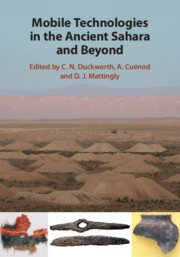Description
Mobile Technologies in the Ancient Sahara and Beyond
Trans-Saharan Archaeology Series
Coordinators: Duckworth C. N., Cuénod A., Mattingly D. J.
Examines key technological innovations, knowledge transfer, connectivity and social meaning in the ancient and Medieval Sahara.
Language: English
Prix indicatif 121,50 €
Disponible chez l'éditeur (délai d'approvisionnement : 14 jours).
Add to cart
Publication date: 09-2020
400 p. · 18x25.2 cm · Relié
400 p. · 18x25.2 cm · Relié
Résumé
/li>Sommaire
/li>Biographie
/li>
The ancient Sahara has often been treated as a periphery or barrier, but this agenda-setting book ? the final volume of the Trans-Saharan Archaeology Series ? demonstrates that it was teeming with technological innovations, knowledge transfer, and trade from long before the Islamic period. In each chapter, expert authors present important syntheses, and new evidence for technologies from oasis farming and irrigation, animal husbandry and textile weaving, to pottery, glass and metal making by groups inhabiting the Sahara and contiguous zones. Scientific analysis is brought together with anthropology and archaeology. The resultant picture of transformations in technologies between the third millennium BC and the second millennium AD is rich and detailed, including analysis of the relationship between the different materials and techniques discussed, and demonstrating the significance of the Sahara both in its own right and in telling the stories of neighbouring regions.
1. Debating Mobile Technologies Chloë N. Duckworth, Aurélie Cuénod and David J. Mattingly; 2. Technological Innovations Transfer Through the Hyper-Arid Belt Mario Liverani; 3. Diffusion of Irrigation Technologies in the Sahara Andrew Wilson, David J. Mattingly and Martin Sterry; 4. Crafts in Roman North Africa Touatia Amraoui; 5. Movement and Management of Animals from 1000 BC to AD 1000 B. Tyr Fothergill, Veerle Linseele and Silvia Valenzuela Lamas; 6. The Early History of Weaving in West Africa Sonja Magnavita; 7. Metalworking: A View from the Garamantian Oases Aurélie Cuénod; 8. Archaeometallurgical Record of Meroe in a Trans-Saharan Landscape Jane Humphris; 9. Meaning of the Variability in Ancient Ironworking in West Africa Caroline Robion-Brunner; 10. Shattering Illusions: Glass production and Trade Within Africa Chloë N. Duckworth; 11. Glass Beads in African Society Peter Robertshaw; 12. Three Millennia of Egyptian Glass Making Thilo Rehren and Daniela Rosenow; 13. Ceramic Technology: Trans-Saharan Perspectives Maria Carmela Gatto; 14. Concluding Discussion Chloë N. Duckworth, Aurélie Cuénod and David J. Mattingly
CHLOE N. DUCKWORTH is a Lecturer in Archaeological Materials Science at Newcastle University, specialising in the archaeology of technology, and particularly in the multidisciplinary investigation of ancient and medieval glasses, from experimental reconstruction of furnaces and glass objects, to the use of historical texts, to chemical and stylistic analysis.
AURÉLIE CUÉNOD is an Honorary Visiting Fellow at the University of Leicester. Her research has focused on metal production and trade in the Pre-Islamic Sahara. She has in particular studied the metalworking evidence from Fazzan in Libya as a member of the Trans-SAHARA Project and participated to field and laboratory research on the metals of southern Morocco for the Middle Draa Project.
DAVID J. MATTINGLY is Professor of Roman Archaeology at the University of Leicester. He has worked in the Sahara for forty years and is the author of many books and articles related to Saharan archaeology, such as Farming the Desert (2 vols, 1996), which won the James R. Wiseman book award of the American Institute of Archaeology, and The Archaeology of Fazzan series (4 vols, 2003–2013). He was the principal investigator of the European Research Council-funded Trans-SAHARA Project (2011–2017) which created the groundwork for this volume, and he is the overall series editor of Trans-Saharan Archaeology, in which this is the final instalment of four volumes.
AURÉLIE CUÉNOD is an Honorary Visiting Fellow at the University of Leicester. Her research has focused on metal production and trade in the Pre-Islamic Sahara. She has in particular studied the metalworking evidence from Fazzan in Libya as a member of the Trans-SAHARA Project and participated to field and laboratory research on the metals of southern Morocco for the Middle Draa Project.
DAVID J. MATTINGLY is Professor of Roman Archaeology at the University of Leicester. He has worked in the Sahara for forty years and is the author of many books and articles related to Saharan archaeology, such as Farming the Desert (2 vols, 1996), which won the James R. Wiseman book award of the American Institute of Archaeology, and The Archaeology of Fazzan series (4 vols, 2003–2013). He was the principal investigator of the European Research Council-funded Trans-SAHARA Project (2011–2017) which created the groundwork for this volume, and he is the overall series editor of Trans-Saharan Archaeology, in which this is the final instalment of four volumes.
© 2024 LAVOISIER S.A.S.




